Rick's b.log - 2017/11/28
You are 18.191.9.9, pleased to meet you!
Rick's b.log - 2017/11/28 |
|
| It is the 24th of November 2024 You are 18.191.9.9, pleased to meet you! |
|
mailto: blog -at- heyrick -dot- eu
You can tell there's a "but" coming, right?
It's always the same issue. The cable to the headphones is three twists of fairly flimsy enamelled braid wrapped in a bit of rubber. The 3.5mm headphone plug is fairly solid, so the obvious place where the cable will flex with movement in a way liable to break it is right at the place where the cable protrudes from the plug.
Of course, this is Rick's b.log and the big (fake) gold coloured replacement audio plug might have been a giveaway. I'm not going to throw away a perfectly reasonable set of headphones because the part that always fails just failed.
Seriously. Five minutes. It'll take you longer to read this.
You will need:
First check that your replacement plug actually works. Push it into your phone, or whatever it is that you listen to the most. Some of the cheap imports are not an identical size to proper audio plugs. 3.4mm or whatever may not seem a big deal, but if it keeps falling out, it'll annoy you in no time. If the fit is not perfectly snug (or at least as snug as the plug you are currently using), throw the replacement plug in the bin and go give that product a one-star rating.
Okay, that done, it's time to plug your soldering iron in, leave it to warm up. Whether or not this is really a five minute job depends a lot on how long it takes your iron to reach working temperature.
Cut the dud audio plug off of the headphone's cable. It's broken, it's no good to us.
Of the replacement plug, hold the plug part in one hand and twist the body. It unscrews. You may have a springy part sticking out of the end, and a little piece of plastic tubing inside.
Now take the end of the cable and loop it into a little 'U' with about a centimetre and a half of cable looped. With the sharp edge of the scissors, make a tiny incision across the looped part of the cable. I mean, just nick it. If you push too hard (or at all!), you'll go right through the cable - wires and all.
How you continue depends upon your cable. If yours is a combined cable like mine, just roll it around in your fingers and make tiny nicks around the rubber outer. If it's the two-wires-joined (figure eight) style, it's the same basic idea, but you'll need a lot more care as that sort of cable is ridiculously fragile.
When you have nicked the rubber all the way around, you should be able to pinch into it with your fingernails and give it a tug to pull the end of the rubber cable wrapping off.
Examine the cable carefully at the point where you separated the inner wires from the rubber outer. If there is any sign of damage to any of the wires, clip the wires off and repeat the above process.
The copper wire is signal ground. Red is right, and the other (blue) is left.
Now apply solder. You will need to apply solder for a slightly longer time than you think because you are not only soldering the cable to the peg, you are also burning off the enamel that each individual wire is coated in. But don't heat for too long or you risk deforming the plastic parts of the plug. It is better to err on the side of not enough as you can always try again.
If you think you're happy with your soldering, pop your headphones on and then take your plug and insert it into a mobile phone, radio, etc and play something. Does everything sound good?
Once your sound is good, you can unplug your soldering iron. All that remains now is to finish up the job.
That's it. Job done.
Don't buy new headphones if the cable wears out, fix the ones you have!
Earlier in the year, I purchased a set of headphones from Lidl. They could fold up, but unlike my Bluetooth ones (that I no longer use), there was no ribbon cable passing through a tidy joint. These headphones had wires from the head support to the speakers. They looked like they would cope with a lot of use. I think I paid around €8. I wasn't expecting much, but they passed both of my tests with flying colours - the first test was "Shell" by Bana (the Witch Hunter Robin theme - YouTube link) which is used to judge bass response and high frequency at the same time (when the bass kicks in, is it pleasing? can you still hear the hi-hat?). The second test was for overall "richness" (a purely subjective thing) and for this I use the Eufonius rendition of "Chīsana Tenohira" (Clannad soundtrack - YouTube link, and if you like the song, there are ridiculously many versions of it, here's a compilation of loads of them).
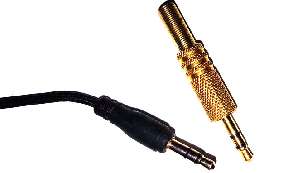
This happens so frequently that you'd think they would sell replacement plugs in supermarkets. But no, we live in a "disposable economy" where it is simpler to throw things away and buy new ones than to repair. For evidence of this, look at how many phones and tablets have their batteries glued in place, have their USB connectors (a rather flimsy interface) mounted in ways that you practically have to destroy parts of the device to get to it (pop over to iFixIt and enjoy their teardowns).
If you are the sort of person who would rather do that than work out which end of a soldering iron is the hot end, then I pity you. Keep reading. It's a five minute job.
Put it back together, then take it apart again. Get to know how it fits together. Then slip everything that isn't the plug end onto the cable. Double-check it's facing the correct direction and is in the right order. Once you've soldered the wires, correcting a mistake here would mean undoing everything.
You will see three tiny twists of wire. One will be copper, one will be red, and one will be another colour - usually blue. You'll probably also see one or two pieces of thread. The thread can be clipped off.
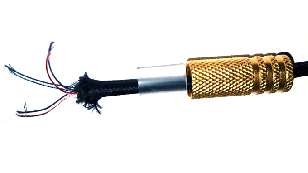
On the headphone plug, the tallest (outer) peg is the signal ground. The middle peg is right, and the shortest (inner) peg is left.
So crimp the cable grip loosely around the cable to hold it in place, and then pass each cable through the appropriate holes in the pegs. It may help to bend the left and right pegs outwards a little.
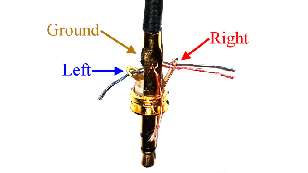
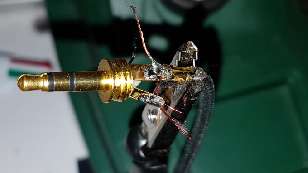
Clip off the ends of the wires (you don't need anything beyond where they are soldered to the pegs).
Now bend the smaller pegs back into place (if you bent them outwards).
With a pair of pliers, or do like I did and cheat and use the handle of the scissors, squeeze the cable clip tight so the cable is held firmly.
Now push the plastic tube into place (if you have one - you should if your plug's body is metal).
Finally, screw the body to the business end of the plug.
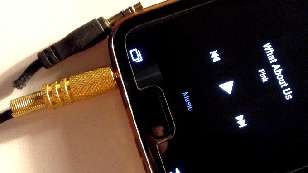
Mick, 5th December 2017, 01:06 Rob, 9th January 2018, 22:34 Rick, 9th January 2018, 23:07
When I was at school, I used to climb trees and God knows what with my Walkman, and those headphones that were like a metal Alice band with lugs at each end. Used to last for ages. I swear the headphones cables they make nowadays are too damn fragile to be of much use if you dare to move while listening...
| © 2017 Rick Murray |
This web page is licenced for your personal, private, non-commercial use only. No automated processing by advertising systems is permitted. RIPA notice: No consent is given for interception of page transmission. |